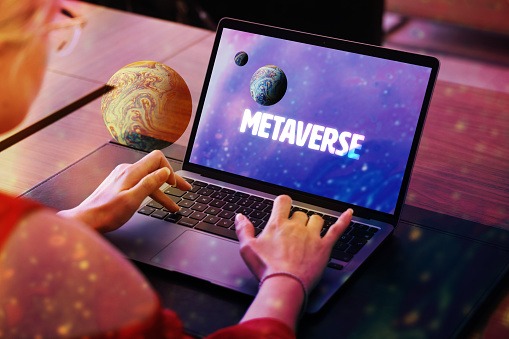Metaverse explained
The Metaverse is a virtual world that incorporates various technologies such as Virtual Reality (VR), Artificial Intelligence (AI), Augmented Reality (AR), Cryptocurrency, etc., allowing users (through VR) to create imaginative or immersive Allows you to immerse themselves in the experience. Their world (via AR). Many metaverses already exist, such as those found in virtual worlds like Decentraland and digital gaming platforms like The Sandbox.
Customers can enter the metaverse through virtual reality accessories such as VR headsets, bridging the apparent gap between digital and physical reality. For example, in virtual reality, you can play games, go to the doctor, go to work, watch a concert, or browse the shelves of the grocery store.

Beyond VR, enhancing the relationship between the physical and digital worlds requires aggressive levels of machine intelligence. As such, some metaverse experiences require artificial intelligence. For example, AI helps natural language processing (that is, the automated computation of human language) to help machines and robots understand what users say.
Augmented reality technology can be used to embed virtual objects into the real environment. Seeing, hearing, touching, and moving are all sensory markers that foster a single conceptual image of the arena in the brain. This can be done in AR with little visual coherence, as long as the geographic and temporal awareness of the virtual components in the environment is strong.
Several companies have been working on different aspects of the metaverse over the past few years, but Internet-native companies such as Facebook (now Meta) and Microsoft have taken the lead. But why are companies investing millions in the Metaverse?
Jefferies, an investment bank, believes investing in the Metaverse is like investing in the early days of the Internet. Additionally, according to Grayscale Investments, the metaverse opportunities extend far beyond games. Expected to be his $1 trillion revenue opportunity spanning hardware, social commerce, digital events, advertising, and creator monetization. Meta CEO Mark Zuckerberg believes that the concept of a digital future is essential to improving the user experience, so he rebranded the company by changing its name from Facebook to Meta. In addition, Facebook’s metaverse is more likely to be accessible via augmented reality, virtual reality headsets, and smart glasses with limited desktop and mobile applications.
The purpose of this article is to explain whether Microsoft has a metaverse, what Facebook’s metaverse is, and compare the two.
How can businesses enter the metaverse?
The immersive setting of the metaverse isn’t just for companies that cater to consumers. Instead, the metaverse has many business applications, including training future surgeons, showing off products, and working with distant relatives.
Brands should always have an attitude of experimentation and learning since the digital environment, in particular, demands intellectual curiosity. The metaverse might represent the next development in how people communicate, interact, and conduct business online. The following actions can be taken by brands to enter the metaverse:
Discover target groups
Explore unmet customer needs and find out how technologies like AR and VR can be used to fill those gaps. Also, find out if the customer is interested in becoming a metaverse.
Conducting competitive analysis
Know what your peers are doing in the metaverse space and how you can launch differentiated products. The other thing you have to find out if your brand’s unique selling proposition and why customers should choose your product over your competitors.
product research
At this stage, you need to find answers to various questions such as B. What can we test in the metaverse space to see if there are more sustainable products? How can you improve the customer experience of your product/service? What features does your product offer?
Balancing for the Metaverse Launch
Involve your research team in developing a strategy for how and when your brand appears in the metaverse. But while doing so, be aware that all new territory comes with risks and rewards. And the unpredictable can happen. Fortunately, the current pandemic has made it easier than ever for us to adapt. Moreover, profit is the return for taking the risk.
facebook and metaverse
Facebook’s renaming to Meta Platforms, or Meta for short, came as a surprise to regular users of the app, but Facebook founder Mark Zuckerberg said the name change meant the company had branched out into multiple claims to indicate that it was connected to a product from He added that Meta better represents what the company is aiming for.
The name change follows the company’s announcement that he intends to employ 10,000 of his people in the EU to build out the “Metaverse”, which he followed in his 2015 reorganization of Google. It’s a move to remember. But why did Facebook change its name to Meta?
Facebook’s rebranding is a great positive move for the company. It focuses on emerging metaverse concepts of virtual communities powered by AR and VR technologies. Meta includes Facebook’s current services such as Facebook, Messenger, Instagram, WhatsApp, and Oculus.
But the problem with Meta’s attempt to be the only company to support the Metaverse is his pivotal role in our lives when his vision of the future becomes a reality. In recent months, the company has faced a core app outage that has left much of the world unresponsive. The impact of such an event in his ubiquitous VR reality like the Metaverse could be immense.
Comparing the Microsoft Metaverse and the Facebook Metaverse
Microsoft not only develops reports and records but also enables collaboration on such documents. Facebook is built on the idea of connecting people. While this is extremely important and necessary for progress in both work and personal life, it is not without its drawbacks.
Microsoft’s vision for the Metaverse is very similar to Facebook’s. However, there are significant differences, such as Facebook being more concerned with Internet-based social media relationships and Microsoft being more focused on work. The concept of Facebook (meta) is more consistent with the sci-fi future tense, a distant future where people spend most of their lives in colorful virtual reality. Microsoft has consistently excelled in this quest, and its collaboration tools and utilities remain a preferred choice in the workplace.
Microsoft is taking a layered approach, incorporating the metaverse concept into contributions to projects like Mesh for Teams, connecting people in mixed reality through work. Meta, by contrast, presents a bottom-up approach to bringing all clients into the Metaverse to play and work there.
Both organizations’ virtual worlds tend to have their abilities. Microsoft understands the corporate side, but Meta understands the social component. Both are the same, so it’s hard to say which dream is more logical.
Microsoft Teams spaces consist of many pre-built dynamic places that can be used in a variety of scenarios, from get-togethers to social mixers. Microsoft expects companies to long-term want to create colorful custom environments like Nth Floor in Mesh and integrate them into Teams.
Horizon Home (the essence of the Quest headset) is an early concept for Facebook’s Metaverse HQ. Friends can now join Horizon Home so they can hang out together, watch videos, and dive into games and apps. Meta will also create virtual homes called “Skyline Homes”. There, you can meet like-minded peers, friends, and others to pursue your interests. Similar to Roblox, but more colorful.
However, Microsoft’s Mesh for Teams starts with a colorful pre-built hangout and social blender. Organizations can also create metaverses within teams where these symbols mingle and where they can collaborate on projects and have happy experiences that stimulate growth.
Microsoft views Teams as a model for the metaverse, where companies can build their virtual worlds and connect a variety of realities, as opposed to dominating its metaverse, as Meta/Facebook appears to want to do. Application programming interfaces can be used by businesses to create their metaverses and maintain a unified brand identity.


















